Purpose Statement
This briefing paper is directed to the management at the small TD branch in British Columbia (BC). The core purpose of this paper is to provide this branch and the Okanagan (Syilx) people with valuable information regarding the on-reserve home loan program. All the necessary aspects, including benefits, disadvantages, and potential opportunities, are presented.
Overview of TD
First of all, it is appropriate to outline the mentioned organization. It was developed by the Aboriginal Banking Group at TD to offer innovative and relevant products and services for the indigenous communities in BC. After thoroughly analyzing and interpreting the aboriginal market, the organization implemented an integrated approach to support it. In particular, TD focuses on the following three aspects: aboriginal customers and markets, talent and employment, and community investment. Meanwhile, TD offerings involve a set of products: personal banking and investing, advisory services, and business banking. In other words, they focus on a wide range of products and services that are available to everyone. TD’s Aboriginal Banking Group gives precise attention to the needs of indigenous customers. Focusing on financial innovation, it proposes a series of oriented programs at individuals and their families and businesses. Such a comprehensive approach allows for covering all the members of a community. TD strives to promote equity by providing fair loan conditions and other financial services and products. For example, one may note the Nisga’a Nation, which received property rights recently.
Benefits, Drawbacks, and Challenges
The on-reserve homeownership program, by its very definition, offers properties on reserve, avoiding government guarantee. The key benefit of this program is that it allows for a cost-effective solution to housing. At the same time, TD offers two options for its customers. According to the first option, a customer going to resolve their housing needs directly connects to a TD representative, which is, undoubtedly, advantageous as no additional actions are required. However, this option is not flexible and may limit some potential borrowers. The corresponding First Nation ensures a guarantee for the support of the members. The second option implies that an individual establishes a direct loan relationship with the First Nation that subsequently connects to TD. The paramount advantage here is the fact that First Nation receives an opportunity to offer more flexible loan terms, thus ensuring the satisfaction of the member’s expectations.
Nonetheless, First Nation has to meet additional requirements rather than its members. Thus, members would own their dwelling while the nation would maintain it. It also seems important to emphasize that members may encounter certain challenges when selecting any of the presented options. They are associated with the Indian Act, several sections of which create difficulties with land securitization.
To address the above challenges, TD initiates the on-reserve homeownership program by building close and trustful relationships with aboriginal communities. Considering the rapidly changing modem world, the organization strives to ensure the appropriate development of the whole country and indigenous communities, particularly as they compose an essential part of Canada. With this in mind, TD is highly motivated to strengthen economic development and let the First Nation representatives achieve their goals. The organization is also motivated to seize its customers’ future by penetrating its culture and promoting its preservation. Also, by organizing indigenous talent and employment, TD promotes social responsibility. For example, such projects as Tree Days or Aboriginal Circle improve the First Nation’s social constituent. Therefore, it invests in aboriginal groups. The detailed information is presented below in Graph 1.
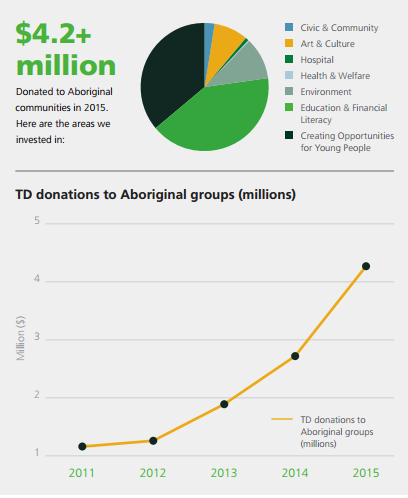
It should be noted that the program’s implementation requires the establishment of relationships with every member so that the collaboration leads to success. Among other benefits to indigenous peoples, there are such opportunities as expanding the aboriginal market and share knowledge with other nations. Even though the program is not likely to be rather profitable for the organization, the First Nation position’s overall improvement seems to be crucial for this branch in the global context. Some mutual benefits that are likely to affect both the selected nation and industry are access to the labor force, marketing and social responsibility, certainty for processes, and access to services.
Okanagan (Syilx) People and TD Branch
In this briefing paper, it is important to identify the on-reserve homeownership program’s target audience: the Okanagan (Syilx) people. This is the indigenous nation living near Okanagan Lake on the border of BC and the United States. The photos that are presented below illustrate the Okanagan (Syilx) people.
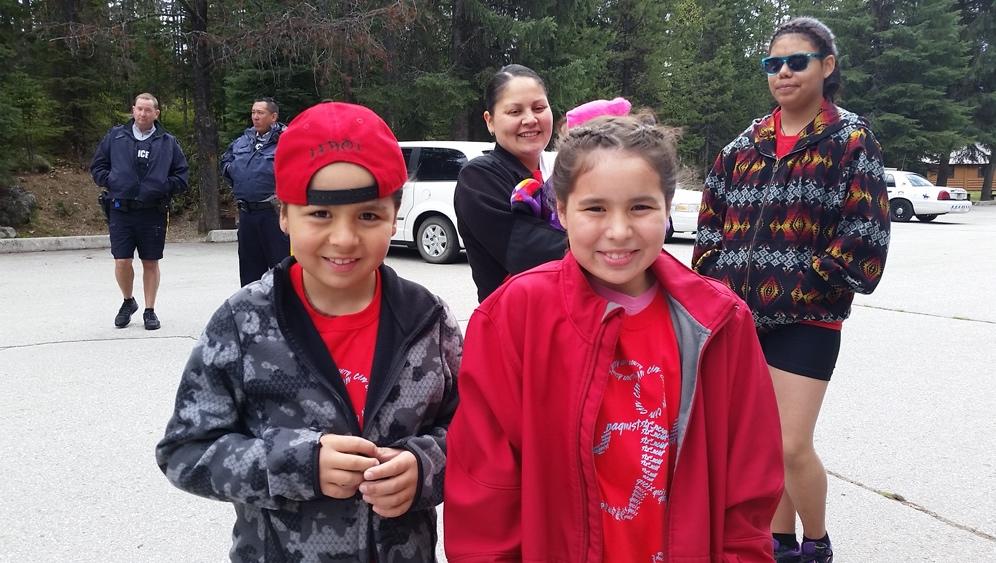
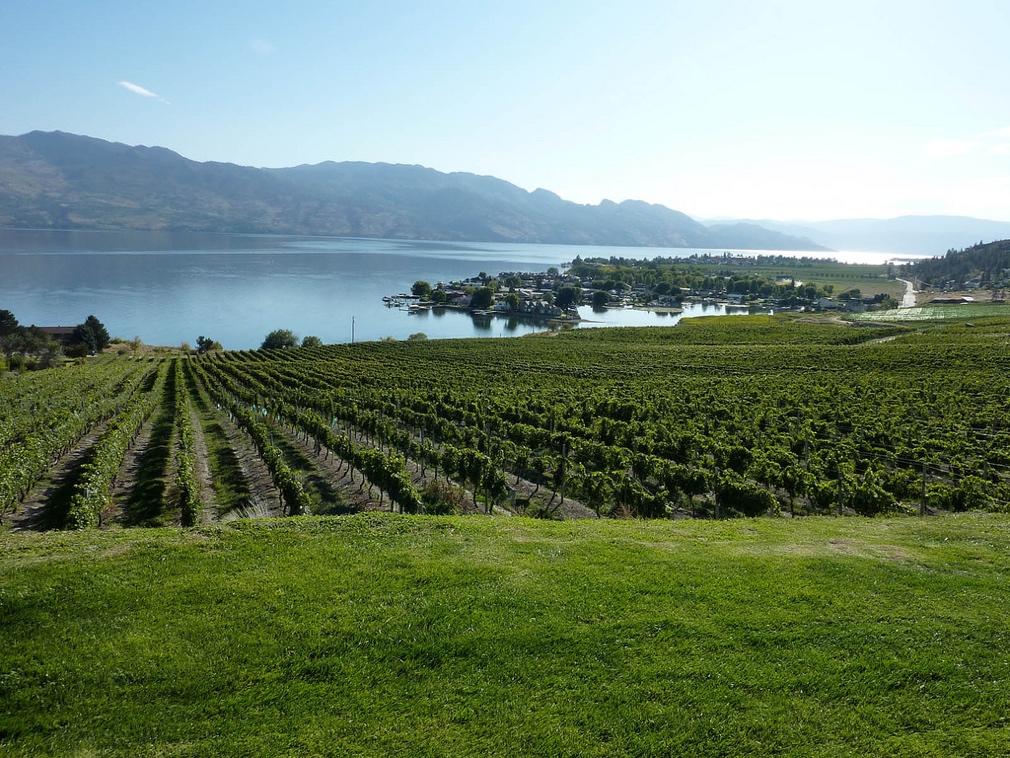
The identified nation is currently governed by the Okanagan Nation Alliance, which was founded in 1981. The Syilx people integrate seven other nations, including Westbank First Nation, Osoyoos Indian Band, Penticton Indian Band, and others. The territory of the Okanagan Nation Alliance is estimated at 69,000 kilometers (Okanagan Nation Alliance). Acting in the regulator’s role, this alliance manages the following fields of public life: administration, business, fisheries and aquatics, wellness, and natural resources. They strive to promote and preserve the national culture and the members’ lands and resources and protect the environment.
The current leadership is held by Pauline Terbasket, the Executive Director (Okanagan Nation Alliance). Each of the departments is led by managers. It is possible to note that leadership is clearly structured and properly organized to provide the best services possible. The official website of the organization offers detailed information related to its representatives. For example, such contact information as phone numbers and emails may be easily accessed. Speaking of housing statistics, one may note that the business development unit is responsible for this aspect—the graphs below present current housing statistics.
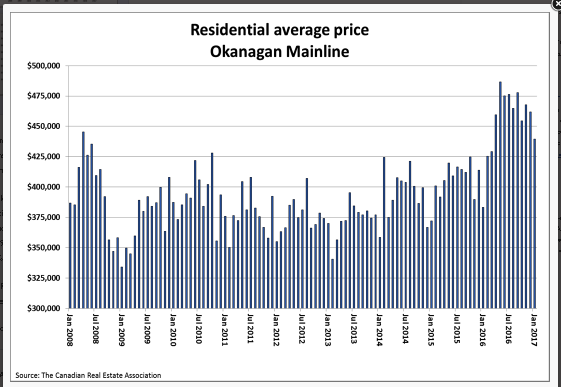
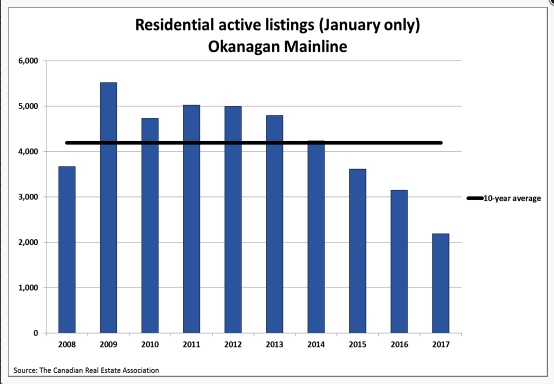
From the above graphs, it becomes evident that there is an obvious decline in residential active listings and growth in average prices compared to the previous years. Therefore, it seems necessary for the Okanagan community to participate in the TD program. Also, the fact that it is located near the Kelowna TD branch simplifies the potential collaboration of members of this community and TD. Additionally, strong leadership and adequate support for its members make Okanagan Nation Alliance look responsible, responsive, and thoughtful. The program implementation and maintenance present minimal risks associated with economic issues, yet the current state of economic indicators is quite stable. On the contrary, the profitability to indigenous people is obvious as they would undoubtedly benefit from the reduced cost of housing and support of their community simultaneously. Taking into account all the listed points, it is recommended to accept the on-reserve homeownership program.
The branch that would be applicable to the identified nation is TD Pacific Region Head Office in Kelowna. The core of suitability lies, as was mentioned earlier in this paper, in the territorial vicinity. Following the pivotal vision of TD, it is of great importance to ensure an individual approach to every member of the First Nation. The thorough analysis of their tenure and specific needs would allow for choosing the best option possible. Kelowna is a small, developing city that may offer plenty of housing variants that may be interesting to the Okanagan people. However, it is necessary to prepare to communicate with them to gain the initial goal. The following section of this briefing paper will address the challenges regarding consultation and relationship building with the First Nation and provide the key points of this process.
Consultation and Relationship Building
Every nation is unique and specific in terms of culture, social position, politics, and even economics. Nonetheless, several strategies can be used to collaborate with them successfully. The first point worth turning one’s attention to is that communication should be transparent, respectful, and involving (Papillon and Juneau 78). Perhaps the key objective is the involvement of the Okanagan people in consultation and relationship building, thus showing their importance in the framework of the whole country. The main role is to create inclusivity and integrity before, during, and after consultation. This may be achieved by the introduction of mutual trust, collaboration, and informed consent.
At the same time, before contacting the identified band, it is important to initiate proper preparation. In particular, management should understand the business realities. They may be different and controversial, yet some tendencies are to be discovered. For example, the Okanagan people have a strong connection with the land, nature, and each other. Respect for each other’s natural resources and support are the two issues that are valued above all. Meanwhile, the fact that land issues are associated with indigenous people’s rights should be considered by the local TD branch as well. Advocacy for their rights requires building close relationships, which need much time and effort.
The next possible step may concern the recognition of capacity challenges. This means their peculiar features may limit the capacity of the First Nation members. It is necessary to assess the level of variability and come up with a corresponding decision. After the evaluation is done, management may begin the engagement policy. At this point, it is recommended to ensure engagement before planning as the first becomes a driving factor, promoting success (Papillon and Juneau 78). Timely engagement helps to avoid any affection on aboriginals’ interests and ethical considerations. Ultimately, it creates a commitment to the program or the project, thus benefiting both the indigenous people and the industry. In general, preparation should be aimed at acquiring information about the selected nation and its traditions, values, leadership, housing data, and all other similar issues to ensure a further convenient consultation.
After that, management may focus on the consultation process that is presented below.

As can be observed from this diagram, the first consultation should be free. This is expected to contribute to the creation of a comfortable and open atmosphere. For the consultation manager, it is crucial to show recognition of the First Nation representative. For example, legal or social aspects of the question may be demonstrated. The next step of the conversation is to understand a certain customer’s needs and set relevant yet feasible goals. The following accommodation phase is presented below in a table format.

The accommodation phase may be followed by the subsequent plan design and decide the First Nation. However, the consultation process cannot be completed without successfully implementing the plan as it is an integral part of TD’s program. Ultimately, monitoring of the program, once it is implemented, is also necessary for terms of control and maintenance. Thus, the described consultation process embraces key points required to engage the Okanagan (Syilx) people and implement the proposed housing program offered by TD.
Conclusion
To conclude, it is necessary to emphasize that TD offers a rather beneficial on-reserve homeownership program for BC’s indigenous people. Among the mutual advantages of this program that would benefit both customers and industry, one may note access to services and employment, recognition, and marketing and social responsibility. This briefing paper proposes the applicability and relevance of the mentioned program to the Okanagan (Syilx) people. To build appropriate relationships with this people group, it is recommended to apply a multi-level consultation process, beginning from preparation and ending with a suitable decision and the future monitoring of its implementation and maintenance.
Works Cited
Okanagan Nation Alliance. Okanagan Nation Alliance, 2017, Web.
Papillon, Martin, and Andre Juneau. Canada: The State of the Federation, 2013: Aboriginal Multilevel Governance. MQUP, 2013.